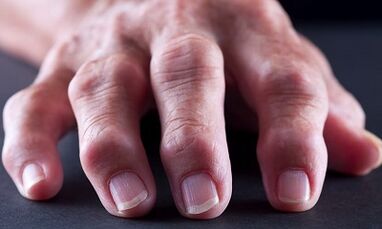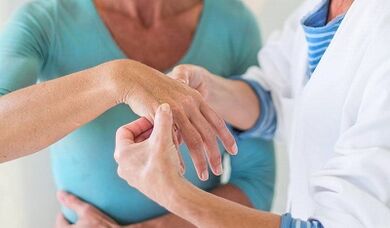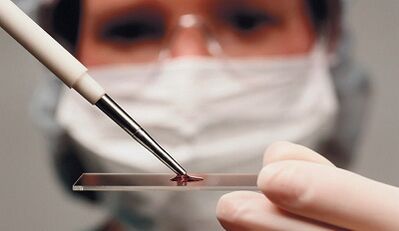Osteoarthritis and arthritis are diseases where joints are affected.Since the names of these disorders are consonant, many people have thoughts about their identity.They perceive these expressions as synonyms, suggesting that this is the same suffering.However, arthosis and arthritis are far from the same and there is a significant difference between it.To understand how arthrosis is different, let's find out what these diseases are.
What is arthritis?
Arthritis is a collective expression that means inflammation of any joints and often indicates more extensive and severe pathological disorders in the body.That is, the disease is inflammatory and can impress both one and more joints.
There are a number of disorders accompanied by the development of arthritis:
- Gout;
- Gout;
- rheumatoid arthritis;
- Systemic lupus erythematosus;
- Psoriasis;
- Hemhramatosis.
In addition, there are reactive arthritis that develops as a result of complications after infectious diseases:
- influenza;
- Syphilis;
- Gonorrhea;
- Mycoplasmosis;
- Chlamydia.
All of these diseases are released in a separate group.
Inflammatory processes for arthritis primarily affect the synovial shell and synovial fluid, causing a disease (synovitis).As a result, the amount of this fluid increases, interpreted by the swelling of the affected joints.The cartilage, which covers the surfaces of the bones, is also inflamed, and over time there is a derosion that expresses that the bone is formed on it.
What is Arthrosis?

Osteoarthritis is a non -inflammatory dystrof disease associated with deformation and destruction of cartilage tissue inside the joint.That is, pathological changes occur, as manifested by dystrophy of cartilage lining of the bones' surfaces.Although it is sometimes a long -term -inflammatory process that provides thinning and damage to the cartilage.Osteoarthritis is often observed in the elderly as they carry cartilage tissue with age, and also osteoporosis occurs, which negatively affects the state of the entire support and engine device.
In some cases, arthrosis may occur at a young age in people experiencing long stresses on the joints.This category includes athletes, people suffering from obesity or people whose professional activity leads to rapid wear of supporting and motor system.
The symptoms of the disease are caused by a violation of the cartilage functions as they are thin and deformed, the bone tissue grows, leading to the inability to deter and friction of the bones forming the joint.As a result, the amount of synovial fluid is reduced, which must enclose the articular surfaces.
General reasons for the development of arthosis and arthritis
As arthosis and arthritis affect the joints, and generally the whole supporting engine is the engine device, these diseases develop as a result of many factors.
Let's look at ten reasons causing these disorders:
- hereditary factor;
- Metabolic violation;
- immunofactor (especially for arthritis);
- Congenital diseases of binding and bone tissue;
- joint damage;
- overweight, obesity;
- Excessive physical activity;
- unbalanced diet;
- Hypothermia;
- infections.
These are general reasons that can cause both arthritis and arthrosis.But this is where their equality ends.Furthermore, the diseases only have differences.
Characteristic causes of development of arthritis and arthrosis
Causes causing arthritis:

- an unbalanced, monotonous nutrition that causes a violation of metabolic processes and immunity (poor nutrition provides the development of infectious diseases, and their drugs penetrate the synovial fluid and cause arthritis);
- Strong hypothermia in the joint (overnight in the tent, bathing in cold water, poor poor shoes and clothing);
- any damage (stretching, bruising or breaking);
- Smoking and obesity;
- A sedentary lifestyle.
The reasons for Arthrosis:
- hereditary factor;
- older age;
- Damage;
- Metabolic diseases.
Previously, the primary (when the cause of the disease was unknown) and the secondary (when the cause became known) the scene in the development of arthrosis.As the more advanced diagnostic methods develop, the primary phase was in doubt as the main cause of the development of arthosis is metabolic disorders in the form of carbohydrate metabolism and ferrous enzymes.Therefore, arthrosis may occur as a result of arthritis, as dystrophy of synovial fluid is nothing but a metabolic disorder.In dystrophic processes, the blood circulation of the joint is disturbed, leading to deterioration of nutrition and destruction of cartilage.
What is the difference between arthritis
Let's look at how arthrosis is different.Since arthritis and arthrosis often affect the same joints, despite this, there is still some pattern in the location of the pathological process:
- Osteoarthritis often develops on large joints in the lower extremities (ankle, knee, hip).In addition, the pathological process develops only in a joint.Throughout life, all these joints experience very heavy stresses, so it is not surprising that they wear out and destroy due to destructive processes.Rarely osteoarthritis affects the joints of the thumbs, hands and intervertebral joints.
- With arthritis, the joints are affected by one, that is, the disease is characteristic of "flying".Suppose the wrist joint was inflamed on one day on the other - the elbow of the third - shoulder joint.In addition, several asymmetrical collections can be inflamed at once.
In addition to the characteristic location of the pathological process, there is a difference between arthritis and arthrosis in symptoms:
- With arthritis, pain occurs at night when a person is at rest.And in the morning, patients feel characteristic stiffness in the affected joints.To relieve stiffness, they have to develop joints.Some patients interpret these phenomena as the norm and forget that healthy people do not need common development after sleep.Their joints are always mobile and functional.With osteoarthritis, such stiffness is not observed.
- In case of arthosis everything happens the other way around.At rest, the patient is relieved as pain occurs only when moving and becomes more intense with significant motor activity.Sometimes with arthosis, pain can also occur at night, but they are associated with the fact that the patient changes the location of the affected limbs in a dream that causes pain.
- The appearance of the joint with arthritis and arthrosis also differs.With arthritis, they swell the metacarpale phalanx joints (convex bones of a compressed fist) and swell, blush and become warm (local temperature rise).With osteoarthritis, such symptoms are not observed, the joint looks quite normal.In the future, of course, a joint deformation may occur as a result of the growth of osteophytes (bone growth on the joints), but even in this case there are no symptoms that are characteristic of arthritis.But with arthosis, a crunch is observed in the affected joint, which is not with arthritis.
It should be noted the general condition of patients in these diseases.With arthritis, a person feels beyond pain in the joint weakness, disorder of a general nature: subfebrile temperature, chills, headaches, appetite, decreased body weight.With osteoarthritis, the problem is only in a non -functional and painful joint, and general symptoms are not observed.
It should be noted that arthritis often leads to arthrosis when the joint is destroyed and changed as a result of inflammation and its mobility is also disturbed.However, inflammatory processes with arthrosis are observed in the joints.Understanding the diagnosis is not that simple, you have to find out the root cause of the development of these disorders.Arthritis usually occurs on the basis of infections that have entered the joint tissue and in the case of arthosis the joint formation occurs due to injury to old age.Of course, inflammation can sometimes join, but this does not always happen.
Differential diagnosis of arthrosis and arthritis
To find out what reason there were problems with the joint, it is necessary to perform differential diagnosis.This diagnosis includes the following clinical tests:
- General blood test.
- General urine analysis;
- biochemical blood test;
- rheumatic tests;
- Autoimmune norms (blood test for antibodies);
- X -Ray of the affected joints;
- Examination of synovial fluid;
- Radioisotopic scan of the skeleton (in some cases);
- Computer tomography (CT);
- Magnetic - Resonance Tomography (CT or MRI).
Blood sample for arthritis and arthrosis
For adequate diagnosis of articular diseases, this procedure is mandatory and necessary.In the case of arthosis, the clinical image of the blood does not change at all, it can only increase beet (reaction of erythrocyte) to 28-30 mm, usually with complication synovitis.With arthritis, the blood image is completely changed: leukocytes rise to 14,000, a displacement of leukocyte formula on the left is observed, level C - reactive protein (CRB) and ROE to 40 - 80 mm climbs.
C - jet in the blood

For differential diagnosis, a biochemical blood test must be performed.With arthritis, there is an increase in inflammation in some immunoglobulins, seromucoid and C - reactive protein, which is not observed with arthrosis.The exact factor that diagnoses the level of the inflammatory process in articular disorders is considered C - reactive protein (CRB).As the synovial fluid responds with increasing protein to the new inflammation, with inflammatory and autoimmune processes in the body, its level increases to 10 mg/l and higher.Compared to healthy people whose reactive protein in the blood does not exceed 0.002 g/l.Thus, the increased level of reactive protein in blood plasma indicates the elaborate development of arthritis.
C - reactive protein (CRB) is a protein in a quick phase that is synthesized in the liver.Activates the body's immune response to the invasion of an inflammatory factor.After 24 hours, the level of reactive protein in plasma increases ten times.With adequate treatment, the protein quickly drops to normal indicators.With osteoarthritis of the patient's blood, the reactive protein indicators remain normal.
X -Ray of the affected collections
This diagnostic method is the second most effective after clinical blood test.In this case, arthrosis is diagnosed precisely, as the degree of bone meal formation with the width of the common hole can be determined on a radiograph.For arthritis, this method is not significant, although it is certainly prescribed as a diagnostic technique.However, this method is imperfect as the degree of damage and destruction of cartilage tissue cannot be seen in the image.
Differences in the treatment of arthritis and arthrosis
Arthritis and arthrosis have different causes and development mechanisms, so their treatment is slightly different.
With arthritis, it is first and foremost necessary to identify the cause of the development of inflammation and neutralize it as soon as possible.If the occurrence of arthritis has an infectious etiology, the patient is prescribed antibiotics.With the autoimmune origin of the disease, cytostatics and hormones are prescribed, and with rising arthritis, uric acid correction in the body is necessary, therefore treatment is performed by hypowefinering drugs.
With Arthrosis, the treatment is aimed at recovering cartilage tissue and the return of common functions.Therefore, treatment of chondroprotectors, hyaluronic acid, physiotherapy, sanitary resort treatment, massage and physical therapy exercises is performed.

Since both arthritis and arthrosis are accompanied by a pronounced pain syndrome, does not -steroidal anti -inflammatory medications for internal and external use (tablets and ointments) as pain relievers with these disorders.Such drugs not only eliminate pain effectively, but also reduces signs of inflammation.
In the treatment of these disorders, both conservative treatment and surgical therapy are used.It all depends on the level and extent of articular lesions.As a rule, this is drug treatment and prosthetics.
As the very fact of the patient's chronic arthritis and arthrosis increases the likelihood of acute relapse, the therapeutic strategy should be aimed at preventing and preventing relapse.The following treatment is prescribed for this:
- Use of non -steroidal anti -inflammatory drugs (NSAIDs).Medicine from this group effectively eliminates signs of inflammation, especially with arthritis, but is always included in the therapeutic complex and with arthrosis.
- The rapid elimination of muscle spasms that occur in the muscles next to the joint.Thus, access to drugs, nutrients and oxygen is provided.
- Normalization of metabolic reactions.This is only possible after stopping the inflammatory process.
- Evacuation from the collection of uric acid salts (if we are talking about a violation of metabolic processes).
- Normalization of acid - alkaline metabolism.
Modern medicine has succeeded in the treatment of arthritis and arthrosis, but despite this, not all cases of arthritis or arthosis end with complete success.
To achieve success in the treatment of these diseases is to relieve inflammation of the joint and muscle spasm in the normalization of metabolic processes and acid -alkalin balance.As a result of these actions, the joint begins to receive full nutrition, oxygen and restore metabolic processes.
Recipes for traditional medicine are very effective in the complex treatment of arthritis and arthrosis.Their use in this format is approved even by official medicine.It should be noted immediately that medical herbs are only an aid in the fight against these disorders.Therefore, before continuing with folk remedies, you must, without failing to apply for recommendations to the participating doctor.
Eating to arthritis and arthrosis
All joints in the joints require, without exception, special dietary nutrition.As the symptoms of arthritis affect the entire organism, its course is in some cases complicated by severe disorders of the heart's work, kidneys and liver, and arthrosis can immobilize the patient, lead to disability, thereby reducing the quality of his life, it is necessary to cast all the forces to fight these ailmets.

In connection with articular pathologies, the body must receive all the necessary nutrients, vitamins and minerals with a particular bias.Normalization of metabolic reactions and acid -alkalin equilibrium is aware of the products.
General nutritional recommendations may be as follows:
- Limit the consumption of red meat (pork, beef, lamb, corners, horses);
- rejection of products containing a large amount of fat and trans fat;
- A complete rejection of alcohol;
- Make a preference for low -fat seafood;
- Consume a large number of vegetables, fruits and herbs (in any form);
- Consumption of dishes based on cartilage: flooding, jelly, jelly, jam;
- ample drinking regime;
- Take supplements with calcium, vitamin A, d and group V.
General Prevention of Gout and Arthrosis
When treating arthritis and arthrosis, the therapeutic strategy consists of preventing and preventing the relapse of arthritis and arthrosis.After all, the disease is easier to warn than to treat.Therefore, the prevention of these disorders has the same principles:
- Avoid hypothermia in the legs (foot joints).After all, it is this path that is the most important thing about worsening chronic diseases and infection with viral infections.
- Timely relief of chronic disorders (tonsillitis, sinusitis, bronchitis).
- Rejection of unpleasant shoes with high heel.Unknown shoes create an extra load on the joints, leading to their destruction, deformation and hyphen and as a result of arthrosis.
- The fight against excess weight.Excess weight is a signal of metabolic disorders, and arthritis almost always occurs on the basis of such violations.
- Moderate physical activity.Heavy work exerts pressure and strain on the joint as a result of being destroyed and inflamed.
- Be sure to adhere to a healthy lifestyle: Often go to the air, rest and eat, engage in physiotherapy exercises, visit a doctor regularly.
Physical physical education for arthritis and arthrosis is a very important part of the therapy in a room with massage, dietary therapy and physical therapy.It provides sore collections with nutrients and oxygen, and without this, their improvement and restoration cannot occur.


















































